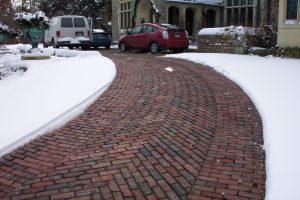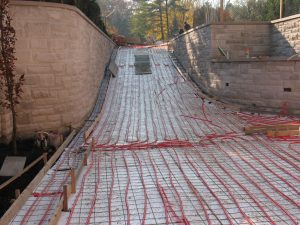
Melting snow is a beautiful thing
August 30, 2017 | By Lance MacNevin
LEARN MORE ABOUT THIS TOPIC AT MODERN HYDRONICS-SUMMIT 2017.
LANCE WILL BE DISCUSSING HYDRONIC SNOW AND ICE MELTNG SYSTEMS IN MORE DETAIL AT THE SUMMIT.
 As I write this it is hard to think about winter, but I am pretty sure it will return this fall. Now is the time to help customers prepare by equipping them with hydronic snow and ice melting systems.
As I write this it is hard to think about winter, but I am pretty sure it will return this fall. Now is the time to help customers prepare by equipping them with hydronic snow and ice melting systems.
Traditional methods of snow and ice removal include “mechanical” removal by snow blowers and plows, manual shoveling, and chemicals such as salt and sand. Sometimes, overhead infrared heaters are used over concentrated locations. If you are lucky, maybe a teenager will do it for cash.
However, shoveling takes huge effort and can cause health issues. Snow blowers and plows are expensive pieces of equipment that consume much fuel and leave snowbanks behind, sometimes damaging landscaping. Salt and sand can damage both outdoor and indoor surfaces while creating environmental issues during run-off.
WHAT IS A SNOW AND ICE MELTING SYSTEM?
Modern hydronic technology can provide responsive and efficient solutions to these problems through snow and ice melting (SIM) systems. These systems have been used across North America in all climates for over 75 years. By heating the outdoor surfaces, snow and ice are melted and evaporated. These closed-loop systems include a heat source, circulating pump/s, controls and other mechanical devices such as expansion tanks.
Such systems were pioneered in the 1940s using wrought iron or steel pipes embedded in concrete, which started rusting shortly thereafter. Modern SIM systems use flexible PEX or PE-RT tubing, the same as used for radiant heating systems. In fact, some people think of SIM systems as outdoor radiant heating systems.
 ADVANTAGES AND APPLICATIONS
ADVANTAGES AND APPLICATIONS
Benefits include safety, convenience, reduced liability, lowered maintenance costs, minimized environmental impact and improved long-term reliability.
SIM systems are used in outdoor areas such as sidewalks, steps, driveways, ramps, parking lots, loading docks, carwashes, roadways, bridges and even helicopter landing pads. They are used at hospitals, train stations, airports, hotels and ski lodges, in addition to light commercial and residential applications.
SIM DESIGN
Doing hydronic system calculations to meet a calculated load is a process that should be well-known to HPAC readers. Or at least, you know someone who can crunch all those numbers for you. Just make sure that antifreeze is included when calculating flow rates and head loss. Try www.plasticpipecalculator.com to help.
For SIM systems, the trickiest part is predicting the loads. It is like predicting the weather. I have seen how often those reporters get it correct, so let’s manage expectations by using the term “estimate,” not “predict.”
Factors that affect SIM loads are air temperature when snowing, rate of snow fall, snow density, wind velocity, humidity level of the atmosphere, slab temperature at start of snowfall, and even the “apparent sky temperature.”
Design methods have been established for years, and much of the information available to designers comes from the ASHRAE HVAC Applications handbook. It guides designers to use SIM heat loads from published tables for US cities or to calculate them directly using equations and weather data, such as from Environment Canada.
Melting snow is basically a three-step process:
1) Warm cold snow or ice to the melting temperature, knowing the heat capacity of snow or ice is 0.51 Btu/lb.
2) Melt the snow into cold water, knowing the latent heat of fusion to change its phase (melt) is 144 Btu/lb.
3) Evaporate the water, changing its phase again. In many installations, the majority of the water simply drains off, saving energy. Otherwise, making the steam rise off the driveway takes quite a bit of energy, especially on a humid day.
Heating loads for these outdoor systems can be in the range of 50 to 300 Btu/ft2 per hour, including reverse loss and edge losses to the cold ground. This is a big range of loads, and it depends upon the jobsite location and customer requirements. Overall sizing has a big impact on initial installation costs, affecting the size of heat sources, gas pipes, boiler piping, circulators, etc. The amount of tubing used in the outdoor surface does not actually vary that much.
For instance, a hospital entrance in Winnipeg may be sized to keep up with 100 per cent of expected snowfalls in that frigid location, and designed to output 300 Btu/ft2 or more. This does not mean that the system will always require 300 Btu/ft2, but the designer might want to design for that capacity when needed.
On the other hand, a residential driveway in Halifax might be sized for lower output, even as low as 50 Btu/ft2. A system of this capacity might not keep up in a worst-case blizzard, but it will catch up and leave a dry surface a few hours later. Designing for a lower capacity can reduce the mechanical system costs (boiler and circulator) significantly. And who needs a perfectly snow-free driveway in the middle of a blizzard, unless to show off to the neighbors?
Work with local hydronic experts that have supplied systems in your locale before and ask them what output they recommend for a given application.
HEAT SOURCES
Earlier, we mentioned the type of heat loads that SIM systems require. This output may be supplied through several types of equipment, such as:
A dedicated boiler sized specifically for the SIM load;
A shared boiler that is also heating the building;
Approved water heater-style heat sources;
A ground source geothermal system using large buffer tanks;
Waste heat from industrial processes, such as in a factory; and
Rejected heat from cooling systems such as in a hockey rink, server building, etc.
SIM systems usually use automatic controls with an outdoor moisture sensor to activate when needed, then turn off when surfaces are dry. This ensures fast response without wasting energy.
TUBING SIZE AND SPACING
SIM systems usually require high flow rates for the worst storms, so 3/4 nominal PEX or PE-RT tubing is typical. Larger projects may even require 1 in. nominal tubing, while 1/2 and 5/8 nominal tubing are used when tighter spacing or low profile is a factor. To support rapid and even melting, most designs use eight to nine inch (20 to 23 cm) tube spacing. Some critical cases use tighter spacing. But going wider than 10 inches (25 cm) runs the risk of snow strips between tubes.
The maximum circuit length depends on the load being delivered and the size of circulators being selected. Fluid can cool off quickly with such high demands, so loop lengths are usually much shorter than with radiant heating systems. Table 3 of CSA B214 actually addresses this. For example, for 3/4 tubing the maximum active loop length is 300 ft. (90 m).
INSULATION
SIM systems work best with insulation as the bottom layer. Otherwise, whether the system is always-on or uses a moisture sensor to activate, a significant amount of heat can be conducted to the frozen earth below the SIM surface. CSA B214 “Installation Code for Hydronic Heating Systems” requires at least R-5 insulation below SIM areas, but many designers specify R-10, since insulation also improves response time. The type of insulation may be extruded polystyrene (XPS), polyurethane (PU) or even expanding foam that is sprayed onto existing concrete or the earth to follow complex contours. Be sure the insulation is rated for outdoor use and meets the expected compressive loading from vehicles, or settling can occur.
TUBING INSTALLATION
Installation of the tubing used for SIM systems is sometimes similar to radiant heating installation, but with different “thermal mass” possibilities. “Thermal mass” simply means the material that will conduct the heat from the warm tubing to the exposed surface, usually concrete, pavers or asphalt. Each type of surface has its own installation techniques.
OPERATING COSTS
Your customers might be missing out on the benefits of snow and ice melting systems because they assume operating costs will be too high. However, many people are surprised to learn that the annual operating costs for a SIM system can be significantly less than for mechanical snow removal. While this article does not show all the math, annual operating costs can be estimated for a given location and application.
With today’s high-efficiency heat sources and low natural gas costs, a hydronic SIM system can offer savings of 50 to 75 per cent of the annual costs for mechanized snow removal. A residential driveway might cost less than $750/year to operate, in many cities. And if it does not snow, operating costs are zero, unlike with an annual snow removal contract.
SUMMARY
By applying radiant heating technology to outdoor surfaces, hydronic snow and ice melting systems provide safe, efficient and reliable means to keep residential and commercial surfaces clear of snow and ice. Though certain installation details are covered here, working with an experienced designer can ensure that installations go smoothly.
 Lance MacNevin, P. Eng. is director of engineering for the Plastics Pipe Institute’s Building and Construction division and a member of CSA’s B214 Technical Committee. He is a mechanical engineering graduate of the University of New Brunswick. He can be reached at lmacnevin@plasticpipe.org.
Lance MacNevin, P. Eng. is director of engineering for the Plastics Pipe Institute’s Building and Construction division and a member of CSA’s B214 Technical Committee. He is a mechanical engineering graduate of the University of New Brunswick. He can be reached at lmacnevin@plasticpipe.org.




